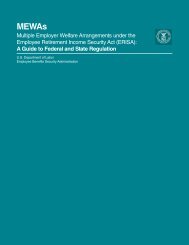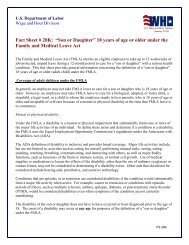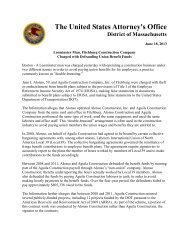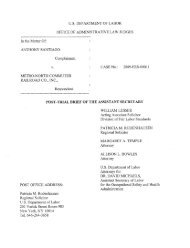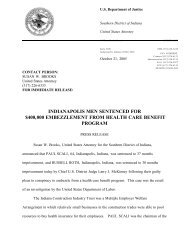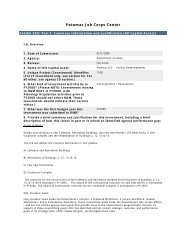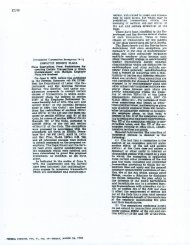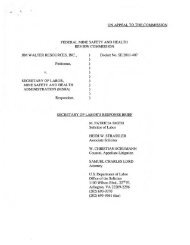- Page 1 and 2: LIST OF CHAPTERS PART 2 - CLAIMS (I
- Page 3 and 4: eference materials, decisions, and
- Page 5 and 6: d. Continuation of Pay. An employee
- Page 7 and 8: o. Review of OWCP Decisions. Under
- Page 10 and 11: 2-0300 COMMUNICATIONS TABLE OF CONT
- Page 12 and 13: 2-0300-4 Regular Correspondence 4.R
- Page 14 and 15: (1) Format. All letters should be p
- Page 16 and 17: If the information requested cannot
- Page 18 and 19: few types of cases are developed in
- Page 20 and 21: c Filing Down. After reviewing or c
- Page 22 and 23: the automated system (see FECA PM 2
- Page 24 and 25: i. Advising the Parties. When case
- Page 26 and 27: (3) Mail and File staff will notify
- Page 28 and 29: 2. Responsibilities. The CE has pri
- Page 30 and 31: DO: Disallowed pending. D1: Denied
- Page 32 and 33: through the system will be given at
- Page 36 and 37: een issued. The pay status is UD. D
- Page 38 and 39: 1. Worksheet for Investigation of F
- Page 40 and 41: medical services received should be
- Page 42 and 43: c. After Assignment for Investigati
- Page 44 and 45: outside of ESA, whether a private c
- Page 46 and 47: materials.
- Page 48 and 49: 2-0500 CONFERENCES TABLE OF CONTENT
- Page 50 and 51: (4) A formal follow-up or comment p
- Page 52 and 53: e. Describe each party’s position
- Page 54 and 55: 12. Conferences 13. Intervention St
- Page 56 and 57: 2-600-2 Introduction 2. Introductio
- Page 58 and 59: Authorizing medical treatment. Auth
- Page 60 and 61: 2-600-4 Case Adjudication 4. Case A
- Page 62 and 63: 2-600-6 Customer Service and Commun
- Page 64 and 65: medical issues. In addition, the cl
- Page 66 and 67: If the surgery is authorized, the C
- Page 68 and 69: address for submission of reports a
- Page 70 and 71: If the CN closes the case and the c
- Page 72 and 73: �������Assist in work
- Page 74 and 75: permissible. The process for extend
- Page 76 and 77: 2-600-9 Vocational Rehabilitation S
- Page 78 and 79: expected after completion of the pr
- Page 80 and 81: 2-600-10 Employing Agency Intervent
- Page 82 and 83: 2-600-11 Claimant Intervention 11.
- Page 84 and 85:
2-600-12 Conferences 12. Conference
- Page 86 and 87:
2-600-13 Intervention Strategies an
- Page 88 and 89:
the various options, the CE needs t
- Page 90 and 91:
c. Return to modified work, with or
- Page 92 and 93:
2-0601 Disability Management Tracki
- Page 94 and 95:
a. Return to Work. Returning the cl
- Page 96 and 97:
(2) COP Nurse Closure. In traumatic
- Page 98 and 99:
further entitlement to compensation
- Page 100 and 101:
esumes, the DM record should be reo
- Page 102 and 103:
DM Tracking, the status code TCQ is
- Page 104 and 105:
(2) RHI (Rehabilitation Plan in Pla
- Page 106 and 107:
specifics of the RTW, the RS enters
- Page 108 and 109:
codes should only be used if a FN o
- Page 110 and 111:
actually close out the DM record on
- Page 112 and 113:
(not CNC) so that the case continue
- Page 114 and 115:
new work stoppage should be reflect
- Page 116 and 117:
2-0700 DEATH CLAIMS TABLE OF CONTEN
- Page 118 and 119:
2-0700-1 Purpose and Scope 1. Purpo
- Page 120 and 121:
c. Notice to Survivors of Right to
- Page 122 and 123:
(a) Four-weekly and monthly compens
- Page 124 and 125:
(3) If the parties lived apart for
- Page 126 and 127:
(3) If the child does not begin pos
- Page 128 and 129:
Compensation was terminated effecti
- Page 130 and 131:
. Dependency Criteria. The test of
- Page 132 and 133:
(3) Proof of physical or mental inc
- Page 134 and 135:
parents would not be harmful). d. D
- Page 136 and 137:
payment regardless of whether the d
- Page 138 and 139:
2-0700-17 Periodic Roll Review 17.
- Page 140 and 141:
(2) If extenuating circumstances ex
- Page 142 and 143:
2-0800-21 FECA Death Gratuity 21. F
- Page 144 and 145:
2-0800 INITIAL DEVELOPMENT OF CLAIM
- Page 146 and 147:
not clearly identified, or the rela
- Page 148 and 149:
claim to the correct type and notif
- Page 150 and 151:
official duties (or an activity inc
- Page 152 and 153:
. Developing the Case. Development
- Page 154 and 155:
since expeditious treatment for the
- Page 156 and 157:
(a) The employing agency should be
- Page 158 and 159:
(4) The agency challenges the claim
- Page 160 and 161:
evidence. In general, medical repor
- Page 162 and 163:
Example: “You have opined that th
- Page 164 and 165:
(2) Cardiac and psychiatric conditi
- Page 166 and 167:
Exhibit 1: Nature of Injury Codes (
- Page 168 and 169:
V9 Virological/Infective/Parasitic,
- Page 170 and 171:
notice of injury or death any writt
- Page 172 and 173:
immediate superior had actual knowl
- Page 174 and 175:
(4) If a claim is not received by O
- Page 176 and 177:
(1) Disappearance During a Period o
- Page 178 and 179:
2-0802 CIVIL EMPLOYEE TABLE OF CONT
- Page 180 and 181:
2-0802-1 Purpose and Scope 1. Purpo
- Page 182 and 183:
2-0802-4 Proof that the Injured/Dec
- Page 184:
. Proof of Status. Any material dis
- Page 187 and 188:
2-0802-10 Volunteer Workers with th
- Page 189 and 190:
2-0802-15 Employees of the U.S. Pro
- Page 191 and 192:
2-0802-18 Cadets at State Maritime
- Page 193:
2-0802-22 Participants in Community
- Page 196 and 197:
2-0802-27 Student Volunteers, Inter
- Page 198 and 199:
2-0802-32 Federal Emergency Managem
- Page 200 and 201:
Establishing whether an injury, tra
- Page 202 and 203:
2-0803-5 Development of Medical Evi
- Page 204 and 205:
1. Purpose and Scope. This chapter
- Page 207 and 208:
(2) In disability cases an explanat
- Page 209 and 210:
(3) Workers having a fixed place of
- Page 211 and 212:
employment, who are injured while o
- Page 213:
is receiving transportation service
- Page 216:
and should show how they acquired t
- Page 219 and 220:
(2) Whether other employees were re
- Page 221 and 222:
Whether a fall at work is idiopathi
- Page 223 and 224:
performance of duty." Thus, under t
- Page 225 and 226:
(3) States how, when, and how often
- Page 227 and 228:
2-0804-14 Statutory Exclusions 14.
- Page 229 and 230:
2-0804-14 Statutory Exclusions (con
- Page 231 and 232:
(2) The official superior should al
- Page 233 and 234:
c. Development. (1) It is the CE's
- Page 235 and 236:
d. OWCP Policy. Employees performin
- Page 237 and 238:
However, the case of Brenda Getz, 3
- Page 239 and 240:
discussion with his supervisor conc
- Page 241 and 242:
ecause the employee's cardiac arres
- Page 243 and 244:
appellant attributes his emotional
- Page 245 and 246:
something the employee did while on
- Page 247 and 248:
j. Developing Factors of Employment
- Page 249 and 250:
When it has been determined that on
- Page 251 and 252:
2-0804-19 Deleterious Effects of Me
- Page 253 and 254:
Paragraph and Subject 2-0805 CAUSAL
- Page 255 and 256:
(1) Temporary aggravation involves
- Page 257 and 258:
(2) If examination or treatment was
- Page 259 and 260:
(6) Certain other kinds of cases re
- Page 261 and 262:
(2) A nurse becomes disabled by pul
- Page 263 and 264:
which includes an opinion concernin
- Page 265 and 266:
Chapter 2-0806, Initial Acceptances
- Page 267 and 268:
sent to the employing agency, and t
- Page 269 and 270:
The following sample language may b
- Page 271 and 272:
condition. When the claimant's inab
- Page 273 and 274:
period immediately following a job-
- Page 275 and 276:
2-0807-5 Employee Status 5. Employe
- Page 277 and 278:
c. End of Period. The claimant's en
- Page 279 and 280:
OWCP requires. g. Claim Forms. The
- Page 281 and 282:
2-0807-11 Regular Pay 11. Regular P
- Page 283 and 284:
2-0807-12 Delayed Disability 12. De
- Page 285 and 286:
(c) Census Enumerators--the date on
- Page 287:
2-0807-15 Relationships Between Lea
- Page 290 and 291:
(b) If the refusal is not found to
- Page 292 and 293:
d. Period of Payment. To determine
- Page 294 and 295:
2-0808 SCHEDULE AWARDS & PERMANENT
- Page 296 and 297:
and the opinion of the District Med
- Page 298 and 299:
those indicated in the FECA. See 5
- Page 300 and 301:
2-0808-7 Payment of Schedule Awards
- Page 302 and 303:
later date which is due to work-rel
- Page 305 and 306:
2-0809 STATEMENTS OF ACCEPTED FACTS
- Page 307 and 308:
elationship is not an issue would n
- Page 309 and 310:
For some types of claims, such as h
- Page 311 and 312:
modifications.) d. SOAF Footer. The
- Page 313 and 314:
a. Evidence. Raw evidence, such as
- Page 315 and 316:
September 10, 2008), in which the a
- Page 317 and 318:
The claim has been accepted for rig
- Page 319 and 320:
2. Several letter carriers were out
- Page 321 and 322:
14. Authorizing Medical Treatment a
- Page 323 and 324:
2-0810-2 Introduction 2. Introducti
- Page 325 and 326:
2-0810-4 Sources of Medical Evidenc
- Page 327 and 328:
under the FECA. See Dona M. Mahurin
- Page 329 and 330:
To be acceptable as medical evidenc
- Page 331 and 332:
not rationalized. The physician sho
- Page 333 and 334:
only once can weigh as heavily as,
- Page 335 and 336:
2-0810-7 Requesting Information fro
- Page 337 and 338:
or sufficient rationale, and the CE
- Page 339 and 340:
Also, where a referee examination i
- Page 341 and 342:
(5) The AP cannot or will not send
- Page 343 and 344:
other physician is supported by obj
- Page 345 and 346:
described. (d) As appropriate, an a
- Page 347 and 348:
attending the second opinion examin
- Page 349 and 350:
issue(s). While the referee’s rep
- Page 351 and 352:
of an excluded medical report were
- Page 353 and 354:
examination under 5 U.S.C. 8123(d).
- Page 355 and 356:
would require a more detailed expla
- Page 357 and 358:
2-0810-16 Functional Capacity Evalu
- Page 359 and 360:
the requested item, the CE should a
- Page 361 and 362:
the facility is fully suitable for
- Page 363 and 364:
above. e. Denial of Approval. If th
- Page 365 and 366:
2-0810-21 Attendant Allowance 21. A
- Page 367 and 368:
2-0811 Nurse Case Management Chapte
- Page 369 and 370:
A Staff Nurse assigned to each dist
- Page 371 and 372:
5. The Field Nurse (FN). A FN is as
- Page 373 and 374:
examples of these instances are: (1
- Page 375 and 376:
notification. (6) Release to return
- Page 377 and 378:
intervention, the CE and the FN wil
- Page 379 and 380:
collaboration between the CE and SN
- Page 381 and 382:
assigned, the FN should be notified
- Page 383 and 384:
clear goals or direction, as well a
- Page 385 and 386:
a. Conference Calls. During the nur
- Page 387 and 388:
FEDERAL (FECA) PROCEDURE MANUAL Cha
- Page 389 and 390:
FEDERAL (FECA) PROCEDURE MANUAL Cha
- Page 391 and 392:
FEDERAL (FECA) PROCEDURE MANUAL Cha
- Page 393 and 394:
FEDERAL (FECA) PROCEDURE MANUAL Cha
- Page 395 and 396:
FEDERAL (FECA) PROCEDURE MANUAL Cha
- Page 397 and 398:
FEDERAL (FECA) PROCEDURE MANUAL Cha
- Page 399 and 400:
FEDERAL (FECA) PROCEDURE MANUAL Cha
- Page 401 and 402:
FEDERAL (FECA) PROCEDURE MANUAL Cha
- Page 403 and 404:
2-0813 Vocational Rehabilitation Se
- Page 406:
When it appears that the claimant
- Page 410:
This chapter explains the procedure
- Page 414:
Lastly, this chapter explains the p
- Page 417:
2. Stautory, Regulatory and Program
- Page 421:
Section 8111 of the Act allows the
- Page 425:
Section 8151 of the Act provides re
- Page 429:
The Code of Federal Regulations dis
- Page 433:
The Vocational Rehabilitation (VR)
- Page 437:
(1) The RS’s responsibilities inc
- Page 441:
(3) The CE’s responsibilities inc
- Page 446:
a. Compensation for Wage Loss. Sect
- Page 450:
c. Schedule Awards. If a claimant r
- Page 455:
4. Restoration Rights with the Fede
- Page 459:
a. OPM’s regulations on retention
- Page 463:
c. When an injured worker resumes e
- Page 468:
5. Referrals for Vocational Rehabil
- Page 472:
If the attending physician cannot f
- Page 476:
. The CE should ensure that the fil
- Page 480:
Note - Prior to referral, the CE sh
- Page 484:
(2) The claimant should be capable
- Page 488:
(4) There should not be any outstan
- Page 492:
d. The FN may recommend a vocationa
- Page 496:
The FN will focus on the medical as
- Page 500:
g. To identify cases for early inte
- Page 504:
i. Making the Referral. The CE refe
- Page 508:
(2) The name of the attending physi
- Page 512:
(4) The date on which disability (o
- Page 516:
(6) Whether or not the CE authorize
- Page 520:
(8) When the case is being referred
- Page 524:
(10) An indication as to whether or
- Page 528:
j. Limited Referrals. If the claima
- Page 532:
(2) An Occupational Rehabilitation
- Page 536 and 537:
The CE should identify the non-empl
- Page 539:
a. Roles and responsibilities. In o
- Page 543:
(a) Refer the claimant to an RC to
- Page 547:
(c) Advise the CE that the case has
- Page 551:
(2) Role of the RC. Working under t
- Page 554:
with the claimant so that all perti
- Page 558:
(4) Role of the claimant. Claimants
- Page 562:
(1) If the employer has shown no in
- Page 566:
c. Interruptions. PPE may be interr
- Page 570:
(1) If the claimant returns to work
- Page 574:
(3) If the EA does not provide an o
- Page 577 and 578:
7. Plan Development. If efforts to
- Page 579 and 580:
sufficient numbers to make successf
- Page 581 and 582:
to the claimant, and the RS will di
- Page 583 and 584:
(3) On-the-job training is another
- Page 585 and 586:
a. Services offered during this pha
- Page 587 and 588:
c. Time Frames. The PNE phase usual
- Page 589 and 590:
(c) It must support an LWEC rating,
- Page 591 and 592:
a. Various medical services can be
- Page 593 and 594:
(7) Reports. The ORP facility must
- Page 595 and 596:
Interrupt status is used when rehab
- Page 597 and 598:
esolve misunderstandings, or provid
- Page 599 and 600:
a. CE Responsibilities. The CE has
- Page 601 and 602:
(3) The CE should appropriately dev
- Page 603 and 604:
wage-earning capacity had he or she
- Page 605 and 606:
days is calculated from the date pl
- Page 607 and 608:
ating of the claimant’s WEC has b
- Page 609 and 610:
a. A conference may be helpful any
- Page 611 and 612:
a. Return to Work with the Previous
- Page 613 and 614:
DFEC has adopted the following defi
- Page 615 and 616:
7. REPETITIVE MOVEMENTS OF WRISTS (
- Page 617 and 618:
2-0814 REEMPLOYMENT: DETERMINING WA
- Page 619 and 620:
Exhibits 1. Sample Letter to Claima
- Page 622 and 623:
. Preliminary Assessment of Positio
- Page 625 and 626:
(b) If the attending physician cont
- Page 627 and 628:
employing agency, however, has an a
- Page 629 and 630:
e. Payment/Reimbursement of Relocat
- Page 631 and 632:
income to the claimant. The CE will
- Page 633 and 634:
on June 5, 1997, returned to work o
- Page 635 and 636:
not equate to a finding that the po
- Page 637 and 638:
imprisonment. The implementing regu
- Page 639 and 640:
coworkers had treated him poorly wh
- Page 641 and 642:
(2) If OWCP is seeking modification
- Page 643 and 644:
. LWEC Determination Not Made. When
- Page 645 and 646:
2-0814 Exhibit 1: Sample Letter To
- Page 647 and 648:
SAMPLE LETTER TO CLAIMANT ADVISING
- Page 649 and 650:
2. Establishing a Pay Rate 3/11 11-
- Page 651 and 652:
letter, secure e-mail with the empl
- Page 653 and 654:
The salary for full-time rural carr
- Page 655 and 656:
(a) Full-time firefighters, such as
- Page 657 and 658:
(1) Career seasonal employment. Thi
- Page 659 and 660:
(which is discussed in further deta
- Page 661 and 662:
of the injury having regard to the
- Page 663 and 664:
so supportive rationale should be i
- Page 665 and 666:
2-0900-5. Effective Date of Pay Rat
- Page 667 and 668:
date, would be used because it was
- Page 669 and 670:
. Administrative Inclusions. It has
- Page 671 and 672:
hourly rate (computed using the 208
- Page 673 and 674:
an employee’s pay rate: (1) Overt
- Page 675 and 676:
shifts (which is the most common si
- Page 677 and 678:
6 days per week, for example. This
- Page 679 and 680:
2-0900-11 Computing Monthly Pay Rat
- Page 681 and 682:
similar employment” under §8114
- Page 683 and 684:
When there is no disability, claima
- Page 685 and 686:
18. Other Payees 12/95 07/00 04/02
- Page 687 and 688:
(d) Death benefits, FECA PM 5-307.
- Page 689 and 690:
(2) The CE is responsible for notin
- Page 691 and 692:
(2) The amounts payable for funeral
- Page 693 and 694:
2-0901-8 Basic Computations 8. Basi
- Page 695 and 696:
c. Conversion from Daily to Weekly
- Page 697 and 698:
Hourly wage X no. of hours per day
- Page 699 and 700:
2-0901-11 Maximum Compensation 11.
- Page 701 and 702:
2-0901-13 (RESERVED) 13. (Reserved)
- Page 703 and 704:
...wages received 2, 5 or 10 years
- Page 705 and 706:
decision is issued do not alter tha
- Page 707 and 708:
injury. The pay rate for the job he
- Page 709 and 710:
e. Representative Payee. When OWCP
- Page 711 and 712:
For example, let us assume that the
- Page 713 and 714:
(3) If the child does not begin pos
- Page 715 and 716:
2 In disability cases, minimum is v
- Page 717 and 718:
01/04/87 31.20-46.80 156.00-234.00
- Page 719 and 720:
6 The amendments of 07/04/66 establ
- Page 721 and 722:
01/01/68 3.7 457 15 09/01/80 4.0 15
- Page 723 and 724:
2-0901 Exhibit 5: Percentage Table
- Page 725 and 726:
PERCENTAGE TABLE OF SCHEDULE AWARDS
- Page 727 and 728:
11 12 cost-of-living increases) 13
- Page 729 and 730:
2-1000-1 Purpose and Scope 1. Purpo
- Page 731 and 732:
compensation payable; (2) In disabi
- Page 733 and 734:
(1) Contact the appropriate person
- Page 735 and 736:
the retirement acts. (2) When an em
- Page 737 and 738:
(b) If there is accrued compensatio
- Page 739 and 740:
Offices (DVARO). In some places the
- Page 741 and 742:
(a) No reduction in a schedule awar
- Page 743 and 744:
d. Obtaining Elections--Educational
- Page 746 and 747:
(3) The CE must advise the claimant
- Page 748 and 749:
c. Injuries On and After September
- Page 750 and 751:
Based on information contained in t
- Page 752 and 753:
2-1000-16 Benefits for Judicial Off
- Page 754 and 755:
the CE should suspend compensation
- Page 756 and 757:
(See PM 2-0814.11.) (6) An employee
- Page 758 and 759:
2-1000 Exhibit 2: OPM Contact List
- Page 761 and 762:
When a third party is or may be leg
- Page 763 and 764:
attorney) (5) Form EN-1108, Long Fo
- Page 765 and 766:
7. Administration of Third Party Ca
- Page 767 and 768:
confirms receipt of the refund and
- Page 769 and 770:
On the written recommendation of th
- Page 771 and 772:
(3) Provide the claimant or attorne
- Page 773 and 774:
any SOR for which a refund check ha
- Page 775 and 776:
In any other case, where a judgment
- Page 777 and 778:
asserted for pain and suffering of
- Page 779 and 780:
h. Costs of Suit. The costs of suit
- Page 781 and 782:
(6) Section 8133(a) of the FECA pro
- Page 783 and 784:
(2) The initial demand letter in an
- Page 785 and 786:
efficiently and effectively accompl
- Page 787 and 788:
procedures for regular third party
- Page 789 and 790:
10.700(b).
- Page 791 and 792:
a. Under 5 U.S.C. § 8127(b) and in
- Page 793 and 794:
. Should an application be submitte
- Page 795 and 796:
(2) The Nature and Complexity of th
- Page 797 and 798:
notice of payment of compensation o
- Page 799 and 800:
(4) The claimant did contest the am
- Page 801 and 802:
2-1300-2 Authority 2. Authority. Se
- Page 803 and 804:
annuity adequate to meet living exp
- Page 805 and 806:
2-1300 Exhibit 1: Sample of Initial
- Page 807 and 808:
FEDERAL EMPLOYEES' COMPENSATION ACT
- Page 809 and 810:
Case Number: Employee: APPEAL REQUE
- Page 811 and 812:
Dear CLAIMANT NAME: I am writing in
- Page 813 and 814:
2-1300 Exhibit 5: Information Neede
- Page 815 and 816:
Notice of Reduction 8. Sample Lette
- Page 817 and 818:
(1) Notification to Claimant. The C
- Page 819 and 820:
See FECA PM 2-0807.10. (2) Particul
- Page 821 and 822:
2-1400-4 Notices of Decision Notice
- Page 823 and 824:
f. Conclusion. Where the decision i
- Page 825 and 826:
approach will assist readers at eve
- Page 827 and 828:
(3) A specific service which the cl
- Page 829 and 830:
2-1400-7 How to Issue Pre-Terminati
- Page 831 and 832:
the claimant for the CE's signature
- Page 833 and 834:
(a) Compensation is being terminate
- Page 835 and 836:
. Source of Advice. District office
- Page 837 and 838:
prior to imprisonment, payment for
- Page 839 and 840:
Basis for Decision: While Dr. Smith
- Page 841 and 842:
2-1400 Exhibit 3: Sample Notice of
- Page 843 and 844:
2-1400 Exhibit 4: Sample Letter Con
- Page 845 and 846:
2-1400 Exhibit 6: Sample Notice of
- Page 847 and 848:
2-1400 Exhibit 8: Sample Letter Con
- Page 849 and 850:
2-1400 Exhibit 10: Sample Letter De
- Page 851 and 852:
FEDERAL (FECA) PROCEDURE MANUAL Cha
- Page 853 and 854:
FEDERAL (FECA) PROCEDURE MANUAL Cha
- Page 855 and 856:
FEDERAL (FECA) PROCEDURE MANUAL Cha
- Page 857 and 858:
FEDERAL (FECA) PROCEDURE MANUAL Cha
- Page 859 and 860:
2-1500 RECURRENCES TABLE OF CONTENT
- Page 861 and 862:
(e.g., "pipeline" grants); (c) True
- Page 863 and 864:
(3) The case was originally accepte
- Page 865 and 866:
c. Case Management. The CE should c
- Page 867 and 868:
determined in its November 24, 1999
- Page 869 and 870:
2-1600 REVIEW PROCESS TABLE OF CONT
- Page 871 and 872:
(2) Any file in which a complaint a
- Page 873 and 874:
1. Purpose and Scope. This chapter
- Page 875 and 876:
5. Review of the Written Record. Th
- Page 877 and 878:
Where it has been determined that a
- Page 879 and 880:
submit any comments and/or document
- Page 881 and 882:
2-1602 RECONSIDERATIONS TABLE OF CO
- Page 883 and 884:
inform the claimant that OWCP will
- Page 885 and 886:
discretion is not subject to review
- Page 887 and 888:
only evidence submitted is cumulati
- Page 889 and 890:
now at issue, the SrCE should prepa
- Page 891 and 892:
2-1603 APPEALS TABLE OF CONTENTS Pa
- Page 893 and 894:
d. Timeliness of Filing. A person r
- Page 895 and 896:
2-1603-6 Cases Returned to District
- Page 897 and 898:
2-1700 SPECIAL ACT CASES TABLE OF C
- Page 899 and 900:
2-1700-4 Peace Corps 4. Peace Corps
- Page 901 and 902:
(2) Staff Spouses. (a) The spouses
- Page 903 and 904:
the children born of such pregnanci
- Page 905 and 906:
(3) Return from Service Abroad. d.
- Page 907 and 908:
(3) Compensation for death will be
- Page 909 and 910:
(1)While at a Job Corps Center, an
- Page 911 and 912:
(1)Enrollees are required to report
- Page 913 and 914:
that observers on vessels that are
- Page 916 and 917:
2-1800 HOUSING & VEHICLE MODIFICATI
- Page 918 and 919:
the appropriate medical specialty.
- Page 920 and 921:
educed by the trade-in value of the
- Page 922 and 923:
available comes with extras (like a
- Page 924 and 925:
of living, due to personal preferen
- Page 926 and 927:
enrichment.” ECAB stated that wit
- Page 928 and 929:
such as increased durability or deg
- Page 930 and 931:
proposal, or review of a submitted
- Page 932 and 933:
collision insurance on vehicles pai
- Page 934 and 935:
By signing this agreement, all part
- Page 936 and 937:
Memorandum of Agreement - Modificat
- Page 938 and 939:
Date: Memorandum of Agreement - Hou





